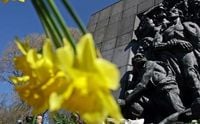On April 19, 2025, the main anniversary celebrations commemorating the Warsaw Ghetto Uprising will begin at noon at the Ghetto Heroes Monument in Muranów. This significant event will see the participation of Jewish community representatives, veterans, Righteous Among the Nations, state and local officials, diplomats, and residents of the capital. In a poignant display of remembrance, alarm signals will sound for one minute in Warsaw and other cities across Poland, marking the occasion with a continuous signal. This act will also serve as a test of the warning system in the capital.
Following the alarm, participants in the Remembrance March will lay flowers at various memorial sites associated with the Warsaw Ghetto. The route of the march will include key locations such as the Ghetto Heroes Monument, the plaque honoring Szmul Zygielbojm at 6 Edelman Street, the Anielewicz bunker at the corner of Miła and Dubois, and Umschlagplatz at 4/6 Stawki Street. Volunteers will be present to distribute paper daffodils, which symbolize remembrance, respect, and hope. This tradition is deeply rooted in the legacy of Marek Edelman, the last leader of the Jewish Combat Organization, who received daffodils each year on the anniversary of the uprising from an anonymous admirer. On every April 19, he would lay a bouquet of these yellow flowers at the Ghetto Heroes Monument.
The yellow daffodil has become a powerful symbol of collective memory, largely due to Edelman's annual tribute. As people gather to remember the Warsaw Ghetto Uprising, many will pin yellow daffodils to their clothing, honoring the date and its significance. The uprising itself, which took place from April 19 to May 15, 1943, represents the most significant act of armed resistance by Jews during World War II. It began when German forces initiated the total liquidation of the Warsaw Ghetto, following earlier deportations of Jews that occurred in 1942 and early 1943.
At the time of the uprising, approximately 50,000 individuals remained in the ghetto. When German troops entered the Jewish district on April 19, they faced fierce resistance from several hundred poorly armed members of the Jewish Combat Organization and the Jewish Military Union. Despite being outnumbered by around 2,000 German soldiers, these brave fighters mounted a courageous defense against the overwhelming odds.
The fighting continued for nearly a month, resulting in devastating losses. Many Jews were killed on the spot—about 7,000 during the battles alone—while others were forcibly transported to the Treblinka extermination camp and various other camps. By the end of the uprising, the entire Jewish district was systematically destroyed, razed to the ground, and those who survived the conflict, the mass executions, and the ensuing fires were mostly sent to their deaths.
Only a handful of the Warsaw Ghetto's inhabitants survived the war, making the annual commemoration all the more significant. The paper daffodil, representing hope and remembrance, serves as a reminder of the resilience and courage displayed by those who fought during the uprising. The event organized by the Museum of the History of Polish Jews POLIN aims not only to preserve this symbol but also to educate the public about the uprising and its historical context.
As the anniversary approaches, the importance of remembering the Warsaw Ghetto Uprising becomes increasingly clear. It stands as a testament to the fight against oppression and the enduring spirit of those who resisted, despite facing insurmountable odds. The yellow daffodil, once a simple flower, has transformed into a potent emblem of collective memory, ensuring that the sacrifices made during this dark chapter in history are never forgotten.
As participants gather at the Ghetto Heroes Monument, the event will not only honor the memory of those who perished but also celebrate the bravery of those who stood up against tyranny. The Remembrance March serves as a powerful reminder of the past, while the distribution of daffodils symbolizes a commitment to remembering the lessons learned and the importance of standing against injustice in all its forms.






